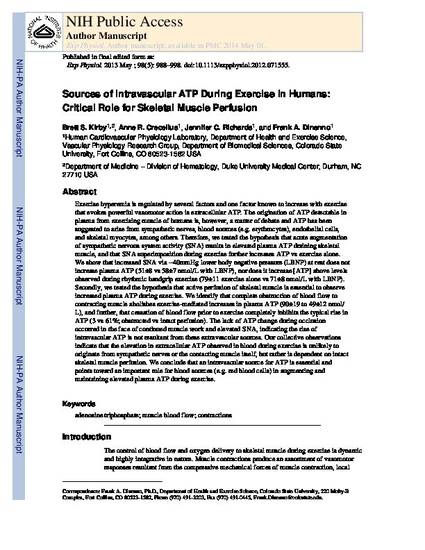
Exercise hyperemia is regulated by several factors and one factor known to increase with exercise that evokes powerful vasomotor action is extracellular ATP. The origination of ATP detectable in plasma from exercising muscle of humans is, however, a matter of debate and ATP has been suggested to arise from sympathetic nerves, blood sources (e.g. erythrocytes), endothelial cells, and skeletal myocytes, among others. Therefore, we tested the hypothesis that acute augmentation of sympathetic nervous system activity (SNA) results in elevated plasma ATP draining skeletal muscle, and that SNA superimposition during exercise further increases ATP vs exercise alone. We show that increased SNA via −40mmHg lower body negative pressure (LBNP) at rest does not increase plasma ATP (51±8 vs 58±7 nmol/L with LBNP), nor does it increase [ATP] above levels observed during rhythmic handgrip exercise (79±11 exercise alone vs 71±8 nmol/L with LBNP). Secondly, we tested the hypothesis that active perfusion of skeletal muscle is essential to observe increased plasma ATP during exercise. We identify that complete obstruction of blood flow to contracting muscle abolishes exercise-mediated increases in plasma ATP (90±19 to 49±12 nmol/L), and further, that cessation of blood flow prior to exercise completely inhibits the typical rise in ATP (3 vs 61%; obstructed vs intact perfusion). The lack of ATP change during occlusion occurred in the face of continued muscle work and elevated SNA, indicating the rise of intravascular ATP is not resultant from these extravascular sources. Our collective observations indicate that the elevation in extracellular ATP observed in blood during exercise is unlikely to originate from sympathetic nerves or the contacting muscle itself, but rather is dependent on intact skeletal muscle perfusion. We conclude that an intravascular source for ATP is essential and points toward an important role for blood sources (e.g. red blood cells) in augmenting and maintaining elevated plasma ATP during exercise.
- adenosine triphosphate,
- muscle blood flow,
- contractions
Available at: http://works.bepress.com/anne_crecelius/1/

This is the accepted version of the following article:
Brett S. Kirby, Anne R. Crecelius, Jennifer C. Richards, and Frank A. Dinenno. “Sources of intravascular ATP during exercise in humans: critical role for skeletal muscle perfusion.” Exp Physiol. May 2013 98 (5) 988-998; published ahead of print January 11, 2013.
The article available in the repository is the author's accepted manuscript; the version of record may contain minor differences that have come about in the copy editing and layout processes.